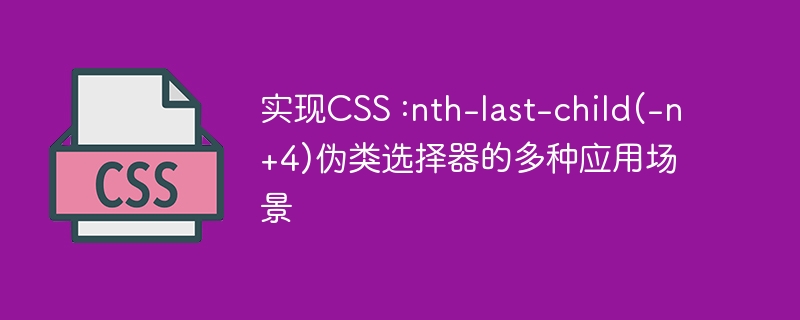 Web Front-end
Web Front-end
 CSS Tutorial
CSS Tutorial
 Implement multiple application scenarios of CSS :nth-last-child(-n+4) pseudo-class selector
Implement multiple application scenarios of CSS :nth-last-child(-n+4) pseudo-class selector
Implement multiple application scenarios of CSS :nth-last-child(-n+4) pseudo-class selector

To implement multiple application scenarios of CSS :nth-last-child(-n 4) pseudo-class selector, specific code examples are required
CSS pseudo-class selection The tool provides us with many convenient ways to select elements. Among them, the :nth-last-child(-n 4) pseudo-class selector is a very useful selector, which can select the fourth to last child and all elements after it. This kind of selector has many application scenarios in actual development. Below I will introduce you to several specific code examples using this pseudo-class selector.
- Navigation bar style
In most website development, we will encounter the design of the navigation bar. Using the :nth-last-child(-n 4) pseudo-class selector, we can easily select the 4th and subsequent elements of the navigation bar and add specific styles to them, such as setting them to not display the bottom border. , to achieve a special effect.
<style>
.nav-bar div:nth-last-child(-n+4) {
border-bottom: none;
}
</style>
<div class="nav-bar">
<div>首页</div>
<div>新闻</div>
<div>产品</div>
<div>关于</div>
<div>联系</div>
<div>更多</div>
</div>- List style
In a list, we may need to add special styles to the fourth to last element and after, such as marking it as important content or Shown in different colors. Using the :nth-last-child(-n 4) pseudo-class selector, we can easily achieve this effect.
<style>
.list-item:nth-last-child(-n+4) {
color: red;
font-weight: bold;
}
</style>
<ul>
<li class="list-item">第1条内容</li>
<li class="list-item">第2条内容</li>
<li class="list-item">第3条内容</li>
<li class="list-item">第4条内容</li>
<li class="list-item">第5条内容</li>
<li class="list-item">第6条内容</li>
</ul>- Table style
In the table, we can use the :nth-last-child(-n 4) pseudo-class selector to select the 4th column from the bottom and For the cells after it, add specific styles to them, such as background color or bold display.
<style>
table td:nth-last-child(-n+4) {
background-color: yellow;
font-weight: bold;
}
</style>
<table>
<tr>
<td>1</td>
<td>2</td>
<td>3</td>
<td>4</td>
<td>5</td>
<td>6</td>
<td>7</td>
<td>8</td>
</tr>
<tr>
<td>1</td>
<td>2</td>
<td>3</td>
<td>4</td>
<td>5</td>
<td>6</td>
<td>7</td>
<td>8</td>
</tr>
</table>Through the above code example, we can see that the nth-last-child(-n 4) pseudo-class selector has many application scenarios in actual development. It gives us more flexibility in selecting elements and adding specific styles to them. Hopefully these examples will help you get better at applying CSS pseudo-class selectors.
The above is the detailed content of Implement multiple application scenarios of CSS :nth-last-child(-n+4) pseudo-class selector. For more information, please follow other related articles on the PHP Chinese website!

Hot AI Tools

Undresser.AI Undress
AI-powered app for creating realistic nude photos

AI Clothes Remover
Online AI tool for removing clothes from photos.

Undress AI Tool
Undress images for free

Clothoff.io
AI clothes remover

Video Face Swap
Swap faces in any video effortlessly with our completely free AI face swap tool!

Hot Article

Hot Tools

Notepad++7.3.1
Easy-to-use and free code editor

SublimeText3 Chinese version
Chinese version, very easy to use

Zend Studio 13.0.1
Powerful PHP integrated development environment

Dreamweaver CS6
Visual web development tools

SublimeText3 Mac version
God-level code editing software (SublimeText3)

Hot Topics
 1393
1393
 52
52
 37
37
 110
110
 How to use bootstrap in vue
Apr 07, 2025 pm 11:33 PM
How to use bootstrap in vue
Apr 07, 2025 pm 11:33 PM
Using Bootstrap in Vue.js is divided into five steps: Install Bootstrap. Import Bootstrap in main.js. Use the Bootstrap component directly in the template. Optional: Custom style. Optional: Use plug-ins.
 The Roles of HTML, CSS, and JavaScript: Core Responsibilities
Apr 08, 2025 pm 07:05 PM
The Roles of HTML, CSS, and JavaScript: Core Responsibilities
Apr 08, 2025 pm 07:05 PM
HTML defines the web structure, CSS is responsible for style and layout, and JavaScript gives dynamic interaction. The three perform their duties in web development and jointly build a colorful website.
 How to write split lines on bootstrap
Apr 07, 2025 pm 03:12 PM
How to write split lines on bootstrap
Apr 07, 2025 pm 03:12 PM
There are two ways to create a Bootstrap split line: using the tag, which creates a horizontal split line. Use the CSS border property to create custom style split lines.
 Understanding HTML, CSS, and JavaScript: A Beginner's Guide
Apr 12, 2025 am 12:02 AM
Understanding HTML, CSS, and JavaScript: A Beginner's Guide
Apr 12, 2025 am 12:02 AM
WebdevelopmentreliesonHTML,CSS,andJavaScript:1)HTMLstructurescontent,2)CSSstylesit,and3)JavaScriptaddsinteractivity,formingthebasisofmodernwebexperiences.
 How to use bootstrap button
Apr 07, 2025 pm 03:09 PM
How to use bootstrap button
Apr 07, 2025 pm 03:09 PM
How to use the Bootstrap button? Introduce Bootstrap CSS to create button elements and add Bootstrap button class to add button text
 How to set up the framework for bootstrap
Apr 07, 2025 pm 03:27 PM
How to set up the framework for bootstrap
Apr 07, 2025 pm 03:27 PM
To set up the Bootstrap framework, you need to follow these steps: 1. Reference the Bootstrap file via CDN; 2. Download and host the file on your own server; 3. Include the Bootstrap file in HTML; 4. Compile Sass/Less as needed; 5. Import a custom file (optional). Once setup is complete, you can use Bootstrap's grid systems, components, and styles to create responsive websites and applications.
 How to insert pictures on bootstrap
Apr 07, 2025 pm 03:30 PM
How to insert pictures on bootstrap
Apr 07, 2025 pm 03:30 PM
There are several ways to insert images in Bootstrap: insert images directly, using the HTML img tag. With the Bootstrap image component, you can provide responsive images and more styles. Set the image size, use the img-fluid class to make the image adaptable. Set the border, using the img-bordered class. Set the rounded corners and use the img-rounded class. Set the shadow, use the shadow class. Resize and position the image, using CSS style. Using the background image, use the background-image CSS property.
 How to resize bootstrap
Apr 07, 2025 pm 03:18 PM
How to resize bootstrap
Apr 07, 2025 pm 03:18 PM
To adjust the size of elements in Bootstrap, you can use the dimension class, which includes: adjusting width: .col-, .w-, .mw-adjust height: .h-, .min-h-, .max-h-



